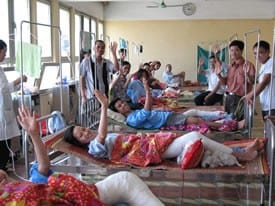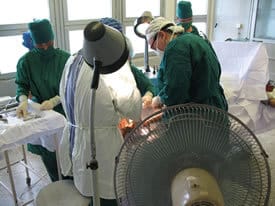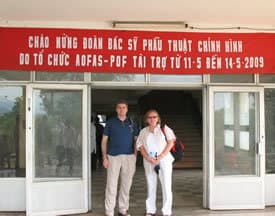UAMS Surgeon Practices Improvisation While Helping Patients in Vietnam
July 21, 2009 | “It was a very make-do situation,” said UAMS orthopaedic surgeon Ruth Thomas, M.D., about her recent medical mission trip to Vietnam, where she encountered outdated technology and surgical cases straight out of a pathology textbook. The two-week visit in May was her fourth to the southeast Asian country and her sixth medical mission with the American Orthopaedic Foot & Ankle Society (AOFAS), of which she chairs the Humanitarian Committee. In her 11 days working at hospitals in Hanoi, Hai Phong and Ba Vi, she and her medical mission team mate, Dr. Mark Slovenkai from Boston, performed 34 surgeries – mainly reconstructive procedures to treat patients suffering deformities related to polio or other diseases that in the United States would likely have been treated early in life. This included one marathon day that involved nine operations. Medical technology available to the surgeons there is 10-15 years behind what is available in the U.S., she said. In addition, many of the operating rooms were poorly lit and lacked adequate climate control. “You have to do the same kind of surgical procedures we do here without the technology we have,” Thomas said, noting that surgeons improvised equipment in some situations or relied on long-outdated techniques. At one point, Thomas improvised a tourniquet from an elastic bandage. On a previous visit she completed a surgery by pen light when the electricity went out. The hospital in Hanoi that hosted the team from the AOFAS is the major trauma center for northern Vietnam. It had technology, including a magnetic resonance imaging (MRI) scanner, that hospitals in the smaller cities lacked, she said. Still, Thomas would not have traded the experience. “There is nothing like it when it comes to patient appreciation,” she said. “These are people, most of them poor, who would never get help if these organizations didn’t come. Even in the communist country with a national health insurance program, the poor cannot get access to care, she said. “Vietnam has about 500 orthopaedic surgeons for a population of more than 86 million,” Thomas said. In the United States, most of the patients born with the club foot deformity are treated while infants or while very young children. In Vietnam, Thomas saw older children and adults who had never been treated and as a result struggled every day with severe, crippling foot deformities. Thomas and Slovenkai worked with the local Vietnamese surgeons and resident physicians, teaching new techniques. She described her Vietnamese hosts as warm and welcoming. “They were pleased to have us there,” said Thomas, who added she forged friendships with her surgical colleagues who still correspond via e-mail with questions about surgical cases or techniques. Thomas was not slated originally to go on the medical mission. She stepped forward just days before the planned departure when a Mexican surgeon was forced to drop out as a precaution due to the outbreak of the H1N1 virus. |


